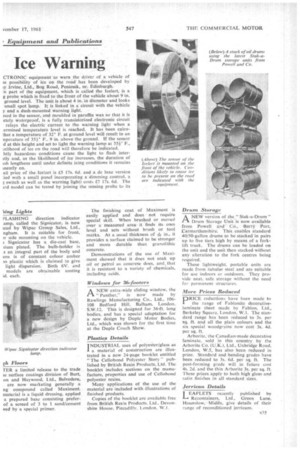Ice Warning
Page 69

If you've noticed an error in this article please click here to report it so we can fix it.
CTRONIC equipment to warn the driver of a vehicle of ke possibility of ice on the road has been developed by ty Irvine, Ltd., Bog Road, Penicuik, nr. Edinburgh.
n part of the equipment, which is called the Icelert, is a g probe which is fixed to the front of the vehicle about 9 in. ground level. The unit is about 4 in. in diameter and looks small spot lamp. It is linked in a circuit with the vehicle y and a dash-mounted warning light.
Bed in the sensor, and moulded in paraffin wax so that it is etely waterproof, is a fully transistorized electronic circuit relays the electric current to the warning light when a .ermined temperature level is reached. It has been calcuthat a temperature of 32° F. at ground level will result in an nperature of 354° F., 9 in. above the ground. If the sensor d at this height and set to light the warning lamp at 351' F., :elihood of ice on the road will therefore be indicated.
htly hazardous conditions cause the light to flash interttly and, as the likelihood of ice increases, the duration of ish lengthens until under definite icing conditions it remains inently on.
ail price of the Icelert is £5 17s. 6d. and a de luxe version .ied with a small panel incorporating a dimming control, a 4 switch as well as the warning light) costs £7 17s. 6d. The ird model can be tested by joining the sensing probe to its




















































































































